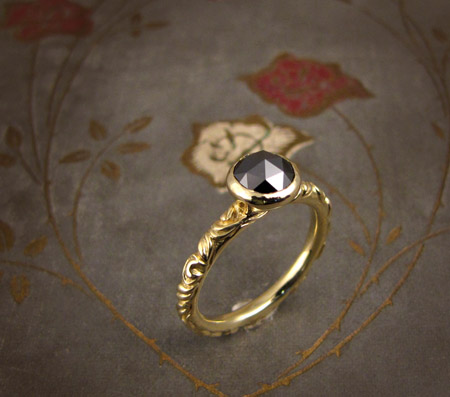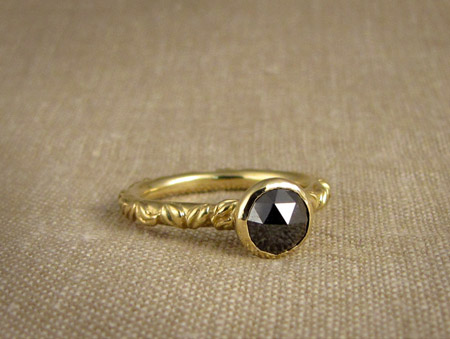I finally got my rose-cut black diamond set in my new ring. Setting a rose-cut stone was harder than I thought. I think I was thinking it would be like a faceted diamond, only easier—more like a cabachon. But no, it was all wobbly and kept flipping around and popping out of the bezel as I tried to set it. I got it in eventually, but it took some figuring out. I’m happy with the look. The black faceted diamond makes me think of Victorian jet. Cool!
This ring would look great with another band of just the tiny leaves.
(Edited to add:) ABOUT THE BLACK DIAMOND: Black diamonds are real diamonds that are mined out of the ground, etc. However, they are treated with radiation to make the color black, which is in fact a super dark green but so dark that it appears totally black. (If you shined a really intense light at the edge of the diamond where it is thinner, you could probably see that it is in fact green in color.) Diamonds do occur naturally with a black color but that color is because of numerous carbon inclusions, which make the stone mostly black and opaque (well, they are more like deep gray with flecks; they do not look perfectly jet black like this stone). Unfortunately, so many inclusions make the stone prone to fracture, and affects the stone’s surface quality (because inclusions usually reach the surface, creating blemishes and affecting the sparkle).
I think that usually, they start with a diamond that is included but not overly so that it would affect it structurally, and maybe it’s also kind of an ugly color–yellowish brown or greenish brown, say. So, they irradiate it and turn it this intense black. I’m not a purist when it comes to cool, so as long as such treatments are plainly disclosed I’m happy to use treated gems. They are usually way cheaper than their naturally occurring counterpart and look just as good (if not better).





Wow really stunning
Very elegant. Very understated. Is a black diamond a “real diamond”? How come you can’t see through it? What makes it black? Does it come out of diamond mines? –Mom
It is a real diamond; however, it is treated with radiation to make the color black, which is in fact a super dark green but so dark that it appears totally black. (If you shined a really bright light at the edge of the diamond where it is thinner, you could probably see that it is in fact green in color.) Diamonds do occur naturally with a black color but that color is because of numerous carbon inclusions, which make the stone mostly black and opaque (well, they are more like deep gray with flecks; they do not look perfectly jet black like this stone). Unfortunately, so many inclusions make the stone prone to fracture, and affects the stone’s surface quality (because inclusions usually reach the surface, making a line or dit, thereby breaking up the shine).
I think that usually, they start with a diamond that is included but not overly so that it would affect it structurally, and maybe it’s also kind of an ugly color–yellowish brown or greenish brown, say. So, they irradiate it and turn it this intense black. I’m not a purist so as long as such treatments are disclosed, I’m happy to use treated gems. They are usually way cheaper than their naturally occurring counterpart and look just as good (if not better). This diamond, as an example, is only $180 (WAY less than a white 1-carat diamond!).
I feel you could write introductions, Bio’s and Personal social comment in many forms. I can almost hear your voice when reading. It’s a gift.
Aloha
Pingback: victorian solitaire with brilliant diamond and matching band « Gin and Butterflies